Dominated by The Appalachian Mountains in the east and the Mississippi River in the west, Tennessee is the 36th largest state in the United States of America. The 16th most populous state in the nation, Tennessee is surrounded by eight other states namely Kentucky, Virginia, North Carolina, Georgia, Alabama, Mississippi, Arkansas, and Missouri.
The state’s capital, Nashville, is not only the largest city (as of 2017) but also the world’s ‘country music capital’. On the other hand, Memphis, a city in south-western Tennessee, is regarded as the birthplace of Rock n’ Roll and home of the Blues.
Tennessee is home to one of the most visited attractions in America – The Great Smoky Mountains National Park. The highest summit on the Appalachian Trail, Clingmans Dome, is also the highest point in the state.
Also known as the Volunteer State, perhaps because of its significant participation during the Battle of New Orleans, Tennessee has a rich history as well as cultural background.
Let us now take a moment to step away from the usual, take a trip down the roads less traveled, and explore some of the hidden gems in Tennessee.
The Secret City – Oak Ridge, TN

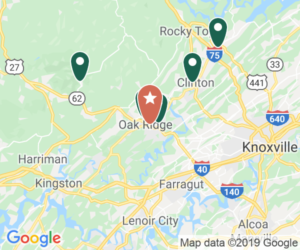
Starting in 1942, the U.S. government began quietly acquiring more than 60,000 acres in Eastern Tennessee for the Manhattan Project—the secret World War II program that developed the atomic bomb. The government needed land to build massive facilities to refine and develop nuclear materials for these new weapons, without attracting the attention of enemy spies. The result was a secret town named Oak Ridge that housed tens of thousands of workers and their families. The entire town and facility were fenced in, with armed guards posted at all entries. Workers were sworn to secrecy and only informed of the specific tasks they needed to perform. Most were unaware of the exact nature of their final product until the nuclear bombs were dropped on Japan in 1945.
Chosen for its remote locale, the entire city had to be built almost from scratch to handle the influx of employee/residents, which ballooned from 3,000 to 75,000 within 3 years. Very few of the employees, most of whom were women, knew what was being built at the time, or exactly what they were getting into. Oak Ridge was, in a lot of ways, just like any quaint southern city—there was an abundance of leisure activities like swimming, a library, 13 grocery stores, an orchestra, and swing dancing. Besides the required badges, guard towers and giant perimeter fence, it was practically a wartime Mayberry. Everyone was quarantined, and their duties left the actual project a mystery, but who would want to leave when they have everything right where they’re at, and who were they to question the government who had given them such a comfortable home and stable employment? It wasn’t until Americans dropped the atomic bomb on Japan that the fine citizens of Oak Ridge realized what they had become a part of.
Two years after WWII ended, the city was relinquished to civilians. When visiting the city today, you can still see some of the old guard towers on the edges of the city, and experience one of the nation’s largest swimming pools still in operation. For $5 with valid US photo identification, you can go on a tour hosted by the American Museum of Science and Energy which includes the old graphite reactors as well as the Y-12 museum in an operational government facility with a billboard right outside that reminds employees to keep secrets a secret.
For a special treat, stop in the museum afterwards to see the brilliant photos of Ed Westcott, the official photographer during wartime.
King Tut Grill – Knoxville, TN
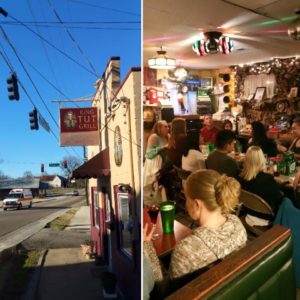
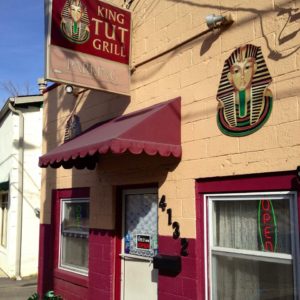
Knoxville has many wonderful things to offer travelers and vacationers headed to or from the Great Smokey Mountains. On the south side of Knoxville, though, nestled between 2 vacant buildings and across from a longtime family furniture store that now hosts martial arts classes is a hidden gem called “King Tut Grill”. On your travels through or to Tennessee, it is an experience not to be missed. Egyptian natives Mo and Seham Girgis had been in Knoxville about 10 years, working at various restaurants and hotels, when they took a chance on their own American dream: owning a restaurant. Though both can cook, Seham makes most of the food and Mo entertains customers — at lunchtime with stories and chess games, at dinner with disco lights, karaoke and wild hats, masks and party props. The restaurant, with an assortment of humorous signs and fun paraphernalia tacked to the walls, has gained a reputation for a quirky place to party while getting food cooked to order that is worth the wait. Many nights, it is at capacity. Expect to drink beer out of a flower vase or perhaps wearing an Egyptian headdress that the restaurant owner whooshes out of the wind. But, mind you, the food here is as good as the entertainment. Try the Greek salad or the Egyptian sampler (you will definitely need to wear the headdress for this).
Moe, the owner, is always smiling and pulling new tricks out of his hat.
The Lost Sea – Sweetwater, TN
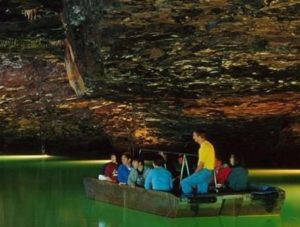
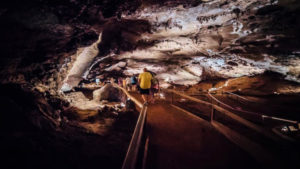
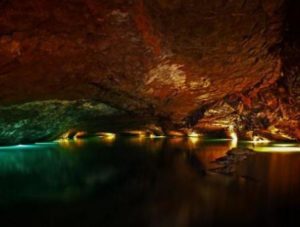
Whitestone provides a great home base from which to venture out toward a variety of East Tennessee attractions. One of my favorites is the world’s largest underwater lake, The Lost Sea, in nearby Sweetwater, TN. This underground body of water is part of a vast series of caves known as Craighead Caverns. In the 1820’s, the first white settlers discovered this cave system, which included numerous huge rooms. From artifacts discovered later, we know that the caves had previously been used by the Cherokee people who inhabited the area. The Lost Sea itself was discovered in 1905 by Ben Sands, a thirteen year old boy who wiggled through a small muddy opening 300 feet underground and found himself in a room that contained a huge lake. He threw mudballs far into the darkness to try to determine its size, but only heard splashes in response. It has since been determined that the visible part of the Lost Sea is 4.5 acres, but even modern technology has not assessed the vast reaches of the unseen body of water.
The Lost Sea is America’s largest underground lake and Registered National Landmark. They are open every day of the year for tours (except Thanksgiving and Christmas Day).
You will love the General Store, Ice Cream Parlor, Gem Mine and Glassblower. Their cafe, the Cavern Kitchen, offers sandwiches and real pit barbeque to hungry visitors. Ample picnic facilities and a nature trail are also available. Your Lost Sea adventure begins with a guided tour of the caverns. This involves a ¾ mile round-trip walk on wide sloping pathways. While touring the caverns and underground lake the guides will tell of the cavern’s exciting and colorful history. They will also explain the fascinating geological development of the immense cavern rooms and rare formations. At the bottom of the cave, you board a glass-bottomed boat and explore the lake itself. The lake is 140 feet underground, so the walk back up can be a hike, but the temperature is always a comfortable 58 degrees. Daily tours last about an hour and fifteen minutes.
While Tennessee has countless hidden gems, just like every state we are visiting, these three are at the top of our list. Join us next week for our episode featuring Arkansas. In the meantime, happy Red Frog travels. 🙂

